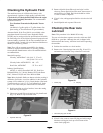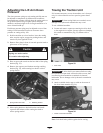
21
1
Figure 16
1. Expansion tank
2. If coolant level is low, remove expansion tank cap and
replenish the system. Do not overfill.
3. Install expansion tank cap.
Filling the Fuel Tank
1. Remove fuel tank cap (Fig. 17).
2. Fill tank to about one inch below top tank, not filler
neck with No. 2 diesel fuel. Then install cap.
Danger
Under certain conditions, diesel fuel and fuel
vapors are highly flammable and explosive. A fire
or explosion from fuel can burn you and others
and can cause property damage.
• Use a funnel and fill the fuel tank outdoors, in
an open area, when the engine is off and is cold.
Wipe up any fuel that spills.
• Do not fill the fuel tank completely full. Add fuel
to the fuel tank until the level is 1/4 to 1/2 in. (6
to 13 mm) below the bottom of the filler neck.
This empty space in the tank allows the fuel to
expand.
• Never smoke when handling fuel, and stay away
from an open flame or where fuel fumes may be
ignited by a spark.
• Store fuel in a clean, safety-approved container
and keep the cap in place.
1
Figure 17
1. Fuel tank cap
Checking the Transmission
Fluid
The front axle housing acts as the reservoir for the system.
The transmission and axle housing are shipped from the
factory with approximately 5 quarts of Mobil 424 hydraulic
fluid. However, check level of transmission oil before
engine is first started and daily thereafter.
1. Position machine on a level surface, lower the cutting
units and stop the engine.
2. Remove floor panel.
3. Unscrew dipstick cap from the transmission filler neck
(Fig. 18) and wipe it with a clean rag. Screw dipstick
into filler neck. Remove the dipstick and check level of
oil. If level is not within 1/2 inch from the groove in the
dipstick, add enough oil to raise level to groove mark.
Do not overfill by more than 1/4 inch above groove.
1
Figure 18
1. Transmission dipstick cap
4. Screw dipstick filler cap finger-tight onto filler neck. It
is not necessary to tighten cap with a wrench.


















